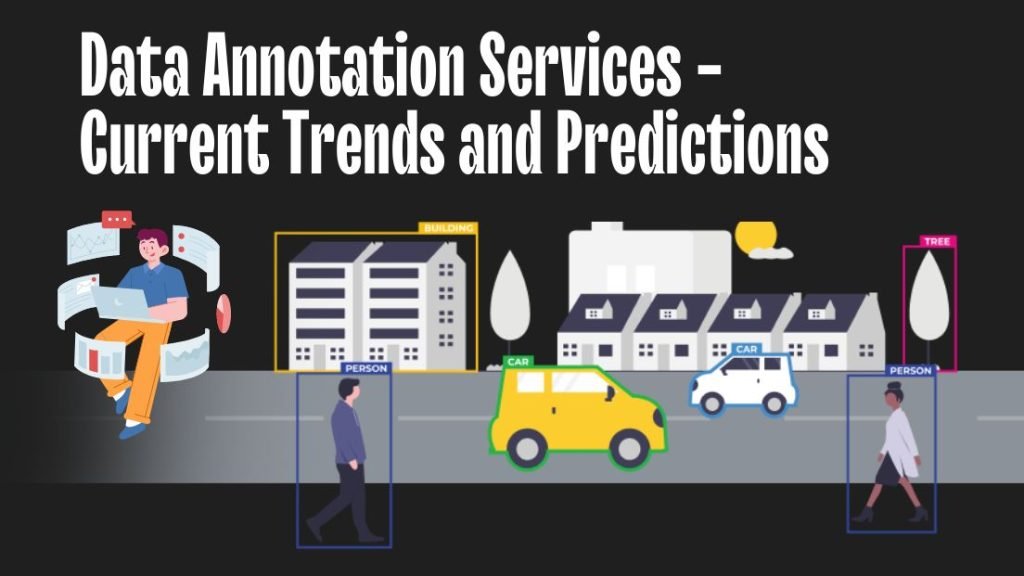Imagine teaching a toddler the difference between a cat and a dog without pointing and stating their names. This parallels the challenge that AI encounters without data annotation – it’s comparable to trying to convey meaning to machine learning models without providing the necessary context. Annotation techniques- whether employing bounding boxes, polygons, or lines- act as the brushstrokes in this process, that paint meaning onto raw data. They are the secret ingredients that enable machines to distinguish a car from a lane of trucks, diagnose diseases through medical scan images, or discern between a dog and a cat.
The significance of data annotation is undeniable. The global market for data annotation and labelling is expected to reach a staggering $3.6 billion by 2027, growing at an impressive rate of 33.2% each year. This growth suggests two aspects:
- Manual annotation methods may struggle to keep up with the growing demand, requiring enhancements for sustained effectiveness.
- A new paradigm is unfolding where humans and machines collaborate to annotate, presenting a more efficient approach to training machines.
To see what reigns, let’s understand current trends and get a glimpse into the exciting future of data annotation.
The current revolution in annotation: From tedious to trendy

A. Automation and AI integration
- Role of machine learning in data annotation
Machine learning acts as the engine that powers the efficiency and accuracy of annotation processes. By leveraging algorithms that learn from patterns and examples, machine learning accelerates the annotation of vast datasets. This not only reduces the burden on human annotators but also enhances the overall quality and speed of data labelling.
- Automated annotation tools and platforms
The rise of automated annotation tools and platforms is reshaping the landscape of data annotation. According to a survey, the global data annotation tools market size, valued at USD 1406.51 million in 2022, is expected to expand at a CAGR of 27.89% reaching USD 6155.48 million by 2028. These tools utilize advanced algorithms to identify and label data points. From image recognition to natural language processing, automated annotation tools streamline the annotation workflow, making it faster and more scalable. This trend is particularly significant in industries dealing with massive datasets, such as autonomous vehicles and healthcare.
B. Quality and diversity
- Importance of high-quality annotations
According to a 2021 study conducted by Gartner, poor data quality costs organizations an average of $12.9 million every year. With the advancement in AI, there’s an increase in the demand for precision and reliability to ensure the accuracy of annotations. Quality annotations contribute to robust model training, reducing the risk of errors and enhancing the model’s ability to generalize across diverse datasets. This emphasizes the continuous need for rigorous quality control measures in data annotation processes.
| “Walmart’s 2019 autonomous floor scrubber implementation faced data quality issues due to incomplete image annotations. The scrubbers collided with obstacles as the algorithm lacked proper training. Walmart addressed this by manually annotating more images, enhancing data quality, and improving the scrubbers’ navigation capabilities. This underscores the importance of precise data annotation for successful AI implementation.” |
- Addressing bias and ethical considerations
With the growing awareness of bias in AI systems, data annotation faces the challenge of ensuring fairness and ethical considerations. However, annotators are now mindful of potential biases that could be inadvertently introduced during the labelling process. Strategies for addressing bias, promoting diversity, and adhering to ethical guidelines are becoming integral parts of data annotation practices, reflecting a commitment to responsible AI development.
C. Industry reliance
- Healthcare becomes more dependent on data annotation
The healthcare industry’s growing dependence on artificial intelligence is expected to propel the market to $67.4 billion by 2027. The increasing integration of AI in healthcare relies heavily on data annotation, particularly in computer vision for medical imaging. AI-powered systems utilize annotated data to identify patterns and detect potential injuries, facilitating automatic report generation post-patient assessment. This trend signifies a fundamental role for data annotation in advancing AI applications, ultimately enhancing diagnostic capabilities and streamlining healthcare processes.
- Data annotation transforming retail and eCommerce
Data annotation serves as a linchpin for enhancing product categorization, search relevance, and customer recommendations. Annotators play a pivotal role by labelling product images with attributes such as colour, size, style, and brand. This empowers AI models to comprehend and effectively categorize products, leading to improved search results and more personalized customer recommendations. As the eCommerce industry evolves, the strategic application of data annotation continues to redefine and elevate the online shopping experience for consumers.
D. Data security and privacy
- Growing concerns and imperative actions
The escalating frequency of data breaches and heightened regulatory scrutiny emphasize the critical need for reinforced data security and privacy measures in the realm of data annotation. The repercussions of compromised data integrity can be severe, necessitating proactive steps to fortify the security infrastructure.
- Proactive measures taken by annotation providers
Annotation and labelling service providers are at the forefront of addressing data privacy concerns by implementing advanced security measures. Robust encryption protocols, stringent access controls, and strict adherence to data protection regulations such as GDPR (General Data Protection Regulation) and CCPA (California Consumer Privacy Act) are becoming standard practices. These proactive steps not only safeguard sensitive information but also instill trust among clients and end-users in an era where data privacy is paramount.
The next frontier: What lies ahead for data annotation?
The field of data annotation is rapidly evolving, with new technologies and techniques emerging all the time. Here are four of the top trends that are shaping the future of data annotation:
1. Automation and efficiency
- Machine learning-assisted annotation: AI models pre-label data with remarkable accuracy, reducing manual workload. These models will continue to learn and adapt, becoming adept at recognizing patterns and nuances. The global machine learning market size, valued at $26.03 billion in 2023, is expected to reach $225.91 billion by 2030.
- Active learning: Algorithms select the most informative data points for annotation, maximizing the efficiency of the process. This optimization will lead to significant improvements in model performance and reduced annotation time.
- Semi-automated annotation tools: These tools will focus on providing annotation suggestions and streamlining workflows, improving overall efficiency.
2. Specialization and domain expertise
- Industry-specific annotation: As AI applications become more specialized, annotators with domain expertise will be increasingly sought-after.
- Multi-modal annotation: Annotators will continue to work with diverse data types like text, images, and audio, creating a holistic picture for AI models. This data fusion will unlock new possibilities and empower AI to operate across various domains.
- Augmented reality (AR) and virtual reality (VR) annotation: Annotating interactive experiences in AR and VR environments will require new tools and techniques
3. New data types and technologies
- Synthetic data: The sophistication of synthetic data generation is steadily increasing, enabling the creation of realistic and representative datasets mirroring real-world data. According to Gartner’s projections, synthetic data is expected to surpass real data dominance in AI models by 2030.
- Unsupervised and weakly supervised learning: By uncovering hidden patterns and relationships within unlabeled data, AI models will automatically generate valuable insights and pre-label data points. This will be suitable for resource-constrained situations.
- Federated learning: This approach enables AI models to learn collaboratively across devices, ensuring privacy. By tapping into decentralized data, federated learning will allow for massive-scale data annotation, unlocking potential in new domains.
4. Human-in-the-loop (HITL) approach
- HITL platforms: Automation tools will not replace human annotators, but rather, work alongside them. HITL platforms will emerge to streamline collaboration between humans and AI models, providing intuitive tools and guidance for enhanced work quality.
- Reliance on third-party service providers: Businesses will continue to rely on data annotation service providers for end-to-end solutions. These providers will prioritize robust quality control and data security frameworks to ensure the integrity and reliability of annotated data.
- Focus on specialization and collaboration: Future developments in data annotation will necessitate specialization, with annotators possessing domain expertise and skills in specific data modalities. Collaborative platforms will facilitate knowledge sharing and best practice development across the global HITL workforce.
Fostering progress: The key lies in evolving
As demand for data annotation skyrockets, companies providing data labelling services emerge as prime targets amid the ongoing AI surge. Success hinges on staying abreast of evolving trends to identify optimal strategies for your business. The data annotation market is poised for significant growth, opening new avenues for AI integration across industries and in our daily lives.


